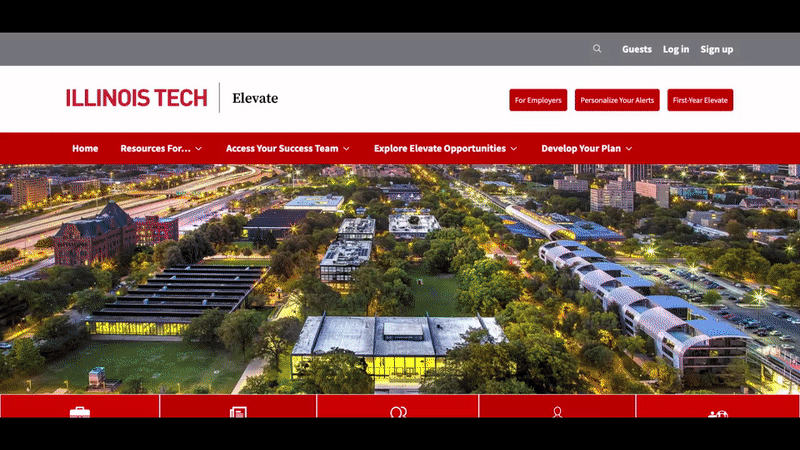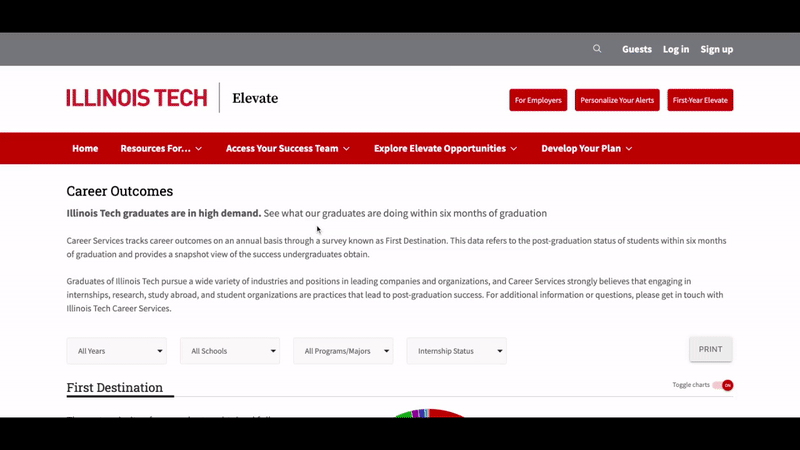
Like many institutions, Illinois Institute of Technology struggled with enrollment after COVID as students took a hard look at the value of higher education in a post-pandemic world.
Applications decreased, deferrals increased, and suddenly, the Chicago-based private university found itself at an important crossroads.

“We realized that we needed a new strategy, that what we were doing wasn’t going to work in this environment,” said Thy Nguyen, Associate Vice Provost for Student Engagement and Career Services at Illinois Tech.
To get back on track, Illinois Tech knew it needed to focus on career readiness. And for Illinois Tech’s high percentage of first-generation undergraduate students, Pell Grant recipients, and international graduate students, that’s a major focus.
“The most common theme was students were thinking about jobs and careers, and thinking about social mobility, as well,” Nguyen said. “We’re one of the leading institutions in the country in terms of raising a family’s socio-economic standing.”
After a year of centering their recruitment strategy around career readiness, and fostering an impressive partnership between enrollment management and career services, Illinois Tech drove its highest enrollment in about 40 years during fall 2022.
Learn more about how Illinois Tech drove record enrollment by focusing on career readiness in our Career Everywhere podcast episode with Thy.
Building a culture of career readiness with Elevate
Illinois Tech’s first step was to build on an existing university framework called Elevate, which promotes the co-curricular, experiential side of an Illinois Tech student’s learning journey. This includes internships (virtual and in-person), study away programs, research, competitions, and more.
After all, according to the National Association of Colleges and Employers (NACE), 91% of employers seek job candidates with work experience and, on average, 80% of eligible interns receive a job offer.
To build out the Elevate framework, Nguyen worked closely with Illinois Tech’s senior leadership, including the president and provost, the vice president for enrollment, and other leaders responsible for undergraduate enrollment and strategic initiatives. While Nguyen’s career services team had an advantageous position being housed under enrollment management, he stresses that’s not the silver bullet.
Rather, he said it all came down to the relationships he and his team had already built across campus.
“It’s easy to say, ‘Oh we’re housed in enrollment management.’ Well that’s a huge division here, probably one of the biggest at the university,” Nguyen said. “And just like you could be housed in other areas like student affairs, you could not know people, not talk to anyone in other areas. So regardless of where you’re housed, I think there needs to be a lot of intentionality in thinking about that strategy, and how you position career services, career outcomes when it comes to the overall recruitment strategy.”
As the only technology-focused university in Chicago, Illinois Tech offers several high-demand degree programs in engineering, science, architecture, business, design, human sciences, applied technology, and law. While that’s an inherent draw to students, Nguyen said the institution struggled to market those programs and distinguish itself in a competitive higher education environment.
That’s where the Elevate portal came in. Built on uConnect’s virtual career center platform, Elevate houses all of Illinois Tech’s experiential learning opportunities and career resources in one place, including:
- Blogs
- Videos
- Events
- Jobs and internships
- Student organizations
- Mentorships
- Study away programs
- Competitions and outside courses
- Leadership opportunities
- Unique/featured classes
- Labor market insights
- Career outcomes data
- And more
One unique feature of the Elevate portal is Blueprint, Illinois Tech’s new signature planning tool that allows students to map out their courses and Elevate opportunities for their Elevate Your Future plan. Students are encouraged to begin using Blueprint the summer before they begin classes at Illinois Tech.
But perhaps two of the most notable (and popular) tools on Elevate are the labor market insights module near the bottom of the homepage and the career outcomes page.
The labor market insights module allows anyone to search any occupation—nationwide or down to the state and county level—and pull up data around employment trends, top employers, annual earnings, in-demand skills, core competencies, and more. Prospective students, parents, current students, alumni, faculty, and staff use the data to inform career pathways, identify and add skills to curriculum, advise students, and more.

Learn more about uConnect’s labor market insights module.
Using outcomes data to attract prospective students
Like many universities, Illinois Tech’s enrollment team sometimes struggled with telling the institution’s story and conveying the ROI of an Illinois Tech degree. One-off student success anecdotes are great, but they don’t show the full picture. They don’t answer the typical parent question: “Okay, but what about the thousands of other Illinois Tech students? What did they do with their Illinois Tech degree?”
That’s why Illinois Tech added a career outcomes page to the Elevate portal. The page includes extensive data, sourced through the annual First Destination survey, that shows exactly what Illinois Tech graduates have gone on to do. Stakeholders can filter the outcomes data by graduation year, schools, degree programs and majors, and internship status. From there, they can see:
- Employment status (full-time, part-time, continuing education, seeking employment, volunteer service, military, etc.)
- Top employers
- Starting salaries
- Employment locations
- Top graduate schools
- Degree types
- Fields of study

“We’re using it in a very intentional way in terms of telling the story for prospective students, and even current students and other stakeholders at the university,” Nguyen said. “One of the challenges in the career services space is talking about career outcomes. And we wanted to make it easier for an external audience to really see the career outcomes and be more transparent about it.”
In addition to making the data accessible externally to students and parents, Nguyen and his team work hard to market the tool internally at Illinois Tech, as well. They keep the data top of mind for senior leadership, faculty, and staff by sending a link to the webpage out to the deans, and they have plans to host town halls and related meetings to review the latest data and more.
Learn more about uConnect’s outcomes data visualization module here.
Driving revenue through recruitment and retention
While many disagree with the concept of operating a college or university like a business, the bottom line (pun intended) is that institutions need to generate revenue. On the academics side, the two key ways to do that are through recruitment and retention.
With Elevate, Illinois Tech has built a sustainable way to drive recruitment and retention at scale by focusing on career resources, readiness, and outcomes.
Now, prospective students (and their parents) can feel more assured about ROI when they choose where to enroll. Admitted students can begin planning their classes and co-curriculars before they step foot on campus.
Current students can access resources that help them explore careers, find internships and experiential learning opportunities, and prepare for life after graduation. (And with increased engagement comes improved retention). Recent grads use Elevate during their first job hunt, including leveraging compensation data during salary negotiations.

Internally, faculty use Elevate to complement their curriculum and identify which skills students will learn in each course. Staff use it to advise students about courses and career preparation. Enrollment management uses it in outreach to prospective students. And finally, senior leadership can use it to tangibly showcase Illnois Tech’s commitment to career readiness to government leaders and other stakeholders.
In short, the Elevate portal (powered by uConnect) has become the one-stop shop for proving the ROI of an Illinois Tech degree. And the results speak for themselves. In less than two years, Illinois Tech went from lagging behind their enrollment goals to breaking records.
“I think universities, in general, are really good at offering experiences and opportunities. I think we’ve done that well for many, many years,” Nguyen said. “What we’re not good at is making those resources apparent to students. Elevate is our attempt to do that. And we quickly realized that uConnect was going to be a big part of that strategy, that this could be our central portal for the experiences at Illinois Tech.”
Advice for other institutions that want to do something similar?
After launching the Elevate platform one year ago, Nguyen has three pieces of advice for other career services teams who may want to try a similar strategy:
1. Be strategic about timing
“Timing is everything. For example, if your university happens to be going through a large-scale strategic envisioning type of session, where you’re thinking about your vision and mission, that could be a good time to really frame the role of career services and how you can be a part of that overall strategy,” Nguyen said.
2. Elevate the career services narrative
“Look at the overall culture of your institution, and think about the perceptions around career services. What’s the real narrative that you want to tell in terms of career services? I think it’s important to constantly be telling your story, because if you don’t, someone else is going to do it for you. Determine your narrative, then tie it into the institutional strategy,” Nguyen said.
3. Hone your themes and operationalize
“From there, we’ve been able to hone in on specific themes. In this case, it’s about the experience and guaranteeing experiences. Next is the hard work, which is how do you operationalize it? It’s not easy, and we certainly don’t have it perfect, not even close. But we’re continuing to iterate and refine as we go along,” Nguyen said.
Want to learn more from Thy about how Illinois Tech drove record enrollment by centering their recruitment strategy around career readiness? Check out this podcast episode where Thy gets into more details and answers questions in a Q&A.
To learn how uConnect can help your career center drive enrollment and retention, fill out the form below to schedule a demo.


